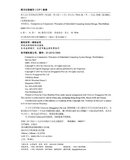书籍详情
![《经典原版书库:嵌入式计算系统设计原理》[42M]百度网盘|亲测有效|pdf下载](/uploads/s0309/rBEQWFE1v1AIAAAAAAET_7gX_aEAABhYwH0E3EAARQX334.jpg)
![《经典原版书库:嵌入式计算系统设计原理》[42M]百度网盘|亲测有效|pdf下载](/uploads/s0309/rBEQWFE1v1AIAAAAAAET_7gX_aEAABhYwH0E3EAARQX334.jpg)
经典原版书库:嵌入式计算系统设计原理
- 出版社:机械工业出版社自营官方旗舰店
- 出版时间:2013-02
- 热度:11260
- 上架时间:2024-06-30 09:08:33
- 价格:0.0
书籍下载
书籍预览
免责声明
本站支持尊重有效期内的版权/著作权,所有的资源均来自于互联网网友分享或网盘资源,一旦发现资源涉及侵权,将立即删除。希望所有用户一同监督并反馈问题,如有侵权请联系站长或发送邮件到ebook666@outlook.com,本站将立马改正
内容介绍
编辑推荐
《经典原版书库:嵌入式计算系统设计原理(英文版·第3版)》特色:
以实际芯片(ARM芯片、T1 C55x DSP和PIC)为例。进行相关设计技术和技巧的说明,向读者介绍如何将这些理论付诸于设计实践。
在所有关键课题讨论中都尤为强调现实中的设计实践,从而为学生和设计人员提供了最先进技术的指导。
对设计实践中所必需的基本应用技术进行重点讨论,帮助读者在实际工作中熟练地设计大型的、复杂的嵌入式系统。
以实际芯片(ARM芯片、T1 C55x DSP和PIC)为例。进行相关设计技术和技巧的说明,向读者介绍如何将这些理论付诸于设计实践。
在所有关键课题讨论中都尤为强调现实中的设计实践,从而为学生和设计人员提供了最先进技术的指导。
对设计实践中所必需的基本应用技术进行重点讨论,帮助读者在实际工作中熟练地设计大型的、复杂的嵌入式系统。
内容简介
《经典原版书库:嵌入式计算系统设计原理(英文版·第3版)》从组件技术的视角出发,介绍了嵌入式系统设计技术和技巧。《经典原版书库:嵌入式计算系统设计原理(英文版·第3版)》自第1版出版以来,已广泛应用于教学,并为实践设计提供了宝贵指南。第3版根据最先进的技术发展进行了更新,更详细阐述操作系统中的进程通信和缓冲,尤其是新增了数字信号处理、多媒体和CPS方面的实例。作者介绍了德州仪器、ARM、美国微芯科技公司的最新处理器及软件、操作系统、网络、消费性电子设备等。不论是进行软硬件设计的研究人员、学生还是专家。都能从Marilyn Wolf的集成化工程设计方法中获益匪浅。
作者简介
Marilyn Wolf,佐治亚理工学院教授,佐治亚研究联合会优秀学者。她分别于1980年、1981年和1984年获得斯坦福大学电子工程学士学位、硕士学位和博士学位。1984年至1989年任职于贝尔实验室,1989年至2007年执教于普林斯顿大学。她是IEEE和ACM会士、IEEE计算机协会核心成员以及ASEE和SPIE成员。她于2003获得ASEE Frederick E. Terman奖,于2006年获得IEEE电路与系统教育奖。她的研究兴趣主要包括嵌入式计算、嵌入式视频和计算机视觉、VLSI系统。
